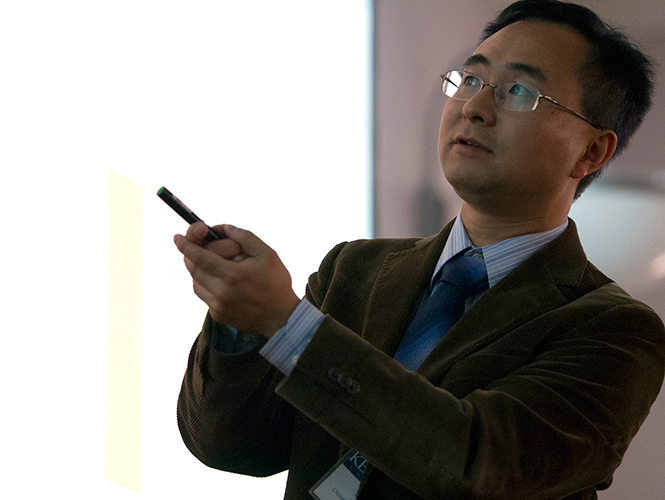Kent State hosts 3rd Annual Organic Photovoltaics Symposium
Doctor Wei You, from the Department of Chemistry at the University of North Carolina at Chapel Hill presented at this years Photovoltaic Symposium held in the Moulton Ballroom on Wednesday April 16th, 2014. Doctor You’s presentation was on Utilizing Conjugated Polymers For Solar Energy Harvesting.
April 16, 2014
Researchers from across the region gathered in Moulton Hall on Wednesday for Kent State’s third annual Symposium on the Advances in Organic Photovoltaics, or OPVs, to present their latest finding on organic photovoltaic materials for flexible solar cells.
Physics professor Satyendra Kumar said OPVs are specialized, carbon-based semiconducting materials used in solar cells, flexible electronics and organic lighting.
“Unlike typical inorganic solar cells that are silicon or thin-film-based, OPVs are flexible and have the potential to be produced at much lower costs than conventional solar cells,” Kumar said.
James Blank, interim dean of the College of Arts and Sciences, said in his opening remarks that this is an opportunity to exchange scientific ideas to further the research initiative.
“Not only is this research area an exciting and relatively new initiative here at Kent State, but it’s an important one as we try to develop and manufacture new renewable energy materials and technologies that are low-cost and efficient, yet rugged and flexible,” Blank said.
Kumar, a chief member of the planning committee, said there is a high concentration of researchers in soft condensed advanced materials. The symposium collaborates with the University of Akron and Case Western University and has attracted people from as far as the University of Michigan.
“This is a growing field,” Kumar said. “In this particular area, which has a higher probability of success, we are one of the only ones who are approaching this with smaller molecules.”
Assistant chemistry professor Barry Dunietz said that the committee worked together to bring a group of high-profile researchers to the symposium, including chemical engineer Zhenan Bao from Stanford University and Lars Müller-Meskamp from Dresden University of Technology in Germany.
“Being on the map of research keeps people interested enough to provide their time and effort to travel and present their research,” Dunietz said. “We have strength in the research of liquid crystals. Using liquid crystals in photovoltaics may be a new direction.”
Dunietz said that photovoltaic technology could be applicable to commercial products within the next five to 10 years with a rapid increase in efficiency in the next years of research.
“The field is waiting for the next big thing to push the photovoltaic efficiencies,” Dunietz said. “Hopefully we answer some basic questions on the fundamentals of how photovoltaics work. Once we do that, we can move forward from there.”
Post-doctorate, graduate and undergraduate research students from around the region presented 18 posters at the symposium. Post-doctorate student Arun Manna said that holding the symposium is important for collaboration and to learn about what other researchers are doing.
“I enjoy learning about others’ research, and it is a great opportunity to exchange ideas with others, learn new things and interact with many scientists and students,” Manna said.
The College of Arts and Sciences, Department of Chemistry and Biochemistry and the Liquid Crystal Institute sponsored this year’s symposium.
Contact Haley Baker at [email protected].

























